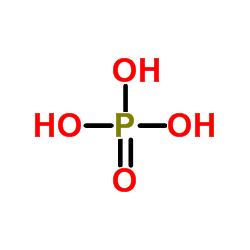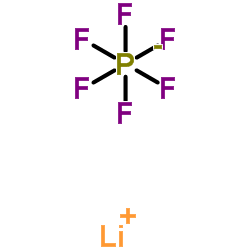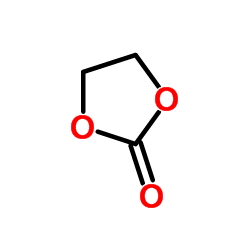13537-32-1
| 中文名 | 单氟磷酸 |
|---|---|
| 英文名 | fluorophosphoric acid |
| 中文别名 |
氟磷酸
一氟磷酸 |
| 英文别名 |
fluorophosphonic acid
FLUOROPHOSPHORIC ACID MFCD00011334 |
| 密度 | 1.83 g/mL at 25 °C |
|---|---|
| 分子式 | FH2O3P |
| 分子量 | 99.98620 |
| 精确质量 | 99.97260 |
| PSA | 67.34000 |
| LogP | 0.04860 |
| 储存条件 | 常温密闭,阴凉通风干燥 |
| 稳定性 | 常温常压下稳定 避免的物料 氧化物 碱。70℃时固化,在中性或者弱碱性溶液中缓慢水解。纯酸或者浓溶液腐蚀大多数金属和合金,包括不锈钢。对银、铂和铝呈惰性。稀溶液可以腐蚀金属铝和钛。 |
| 分子结构 | 1、 摩尔折射率:12.15 2、 摩尔体积(cm3/mol):53.1 3、 等张比容(90.2K):147.2 4、 表面张力(dyne/cm):58.9 5、 极化率(10-24cm3):4.81 |
| 计算化学 | 1、 疏水参数计算参考值(XlogP):-1.1 2、 氢键供体数量:2 3、 氢键受体数量:4 4、 可旋转化学键数量:0 5、 拓扑分子极性表面积(TPSA):57.5 6、 重原子数量:5 7、 表面电荷:0 8、 复杂度:61.3 9、 同位素原子数量:0 10、 确定原子立构中心数量:0 11、 不确定原子立构中心数量:0 12、 确定化学键立构中心数量:0 13、 不确定化学键立构中心数量:0 14、 共价键单元数量:1 |
| 更多 | 1. 性状:无色油状液体,中强酸。 2. 密度(g/mL,25/4℃):未确定 3. 相对蒸汽密度(g/mL,空气=1):未确定 4. 熔点(ºC):未确定 5. 沸点(ºC,常压):未确定 6. 沸点(ºC,5.2kPa):未确定 7. 折射率:未确定 8. 闪点(ºC):未确定 9. 比旋光度(º):未确定 10. 自燃点或引燃温度(ºC):未确定 11. 蒸气压(kPa,25ºC):未确定 12. 饱和蒸气压(kPa,60ºC):未确定 13. 燃烧热(KJ/mol):未确定 14. 临界温度(ºC):未确定 15. 临界压力(KPa):未确定 16. 油水(辛醇/水)分配系数的对数值:未确定 17. 爆炸上限(%,V/V):未确定 18. 爆炸下限(%,V/V):未确定 19. 溶解性:未确定 |
Synonym:Monofluorophosphoric Acid; Phosphorofluoridic Acid Section 2 - COMPOSITION, INFORMATION ON INGREDIENTS
Risk Phrases: 23/24/25 34 Section 3 - HAZARDS IDENTIFICATION EMERGENCY OVERVIEW
Toxic by inhalation, in contact with skin and if swallowed. Causes burns.Hygroscopic (absorbs moisture from the air).Corrosive. Potential Health Effects Eye: Causes eye burns. May cause chemical conjunctivitis and corneal damage. Skin: Causes skin burns. May cause skin rash (in milder cases), and cold and clammy skin with cyanosis or pale color. Ingestion: May cause severe and permanent damage to the digestive tract. Causes gastrointestinal tract burns. May cause perforation of the digestive tract. The toxicological properties of this substance have not been fully investigated. May cause systemic effects. Inhalation: May cause irritation of the respiratory tract with burning pain in the nose and throat, coughing, wheezing, shortness of breath and pulmonary edema. Causes chemical burns to the respiratory tract. Inhalation may be fatal as a result of spasm, inflammation, edema of the larynx and bronchi, chemical pneumonitis and pulmonary edema. Aspiration may lead to pulmonary edema. May cause systemic effects. Chronic: Effects may be delayed. Section 4 - FIRST AID MEASURES Eyes: Get medical aid immediately. Do NOT allow victim to rub eyes or keep eyes closed. Extensive irrigation with water is required (at least 30 minutes). Skin: Get medical aid immediately. Immediately flush skin with plenty of water for at least 15 minutes while removing contaminated clothing and shoes. Wash clothing before reuse. Destroy contaminated shoes. Ingestion: Do not induce vomiting. If victim is conscious and alert, give 2-4 cupfuls of milk or water. Get medical aid immediately. Wash mouth out with water. Inhalation: Remove from exposure and move to fresh air immediately. If not breathing, give artificial respiration. If breathing is difficult, give oxygen. Get medical aid. Do NOT use mouth-to-mouth resuscitation. If breathing has ceased apply artificial respiration using oxygen and a suitable mechanical device such as a bag and a mask. Notes to Physician: Section 5 - FIRE FIGHTING MEASURES General Information: As in any fire, wear a self-contained breathing apparatus in pressure-demand, MSHA/NIOSH (approved or equivalent), and full protective gear. During a fire, irritating and highly toxic gases may be generated by thermal decomposition or combustion. Use water spray to keep fire-exposed containers cool. Vapors may be heavier than air. They can spread along the ground and collect in low or confined areas. Containers may explode when heated. Extinguishing Media: Use dry chemical. Cool containers with flooding quantities of water until well after fire is out. Section 6 - ACCIDENTAL RELEASE MEASURES General Information: Use proper personal protective equipment as indicated in Section 8. Spills/Leaks: Absorb spill with inert material (e.g. vermiculite, sand or earth), then place in suitable container. Avoid runoff into storm sewers and ditches which lead to waterways. Clean up spills immediately, observing precautions in the Protective Equipment section. Provide ventilation. Section 7 - HANDLING and STORAGE Handling: Keep container tightly closed. Do not get on skin or in eyes. Do not ingest or inhale. Use with adequate ventilation. Use and store under nitrogen. Use only in a chemical fume hood. Discard contaminated shoes. Storage: Store in a cool, dry place. Store in a tightly closed container. Corrosives area. Store protected from moisture. Section 8 - EXPOSURE CONTROLS, PERSONAL PROTECTION Engineering Controls: Facilities storing or utilizing this material should be equipped with an eyewash facility and a safety shower. Use adequate ventilation to keep airborne concentrations low. Exposure Limits CAS# 13537-32-1: Personal Protective Equipment Eyes: Wear appropriate protective eyeglasses or chemical safety goggles as described by OSHA's eye and face protection regulations in 29 CFR 1910.133 or European Standard EN166. Skin: Wear appropriate protective gloves to prevent skin exposure. Clothing: Wear appropriate protective clothing to minimize contact with skin. Respirators: A respiratory protection program that meets OSHA's 29 CFR 1910.134 and ANSI Z88.2 requirements or European Standard EN 149 must be followed whenever workplace conditions warrant respirator use. Section 9 - PHYSICAL AND CHEMICAL PROPERTIES Physical State: Liquid Color: colorless Odor: pungent odor pH: Not available. Vapor Pressure: Not available. Viscosity: Not available. Boiling Point: Not available. Freezing/Melting Point: Not available. Autoignition Temperature: Not available. Flash Point: None. Explosion Limits, lower: Not available. Explosion Limits, upper: Not available. Decomposition Temperature: Solubility in water: soluble Specific Gravity/Density: 1.8300g/cm3 Molecular Formula: H2PO3F Molecular Weight: 99.99 Section 10 - STABILITY AND REACTIVITY Chemical Stability: Stable at room temperature in closed containers under normal storage and handling conditions. Conditions to Avoid: Incompatible materials, moisture, excess heat, exposure to moist air or water. Incompatibilities with Other Materials: Moisture, strong bases, strong oxidizing agents. Hazardous Decomposition Products: Phosphine, irritating and toxic fumes and gases, hydrogen fluoride gas. Hazardous Polymerization: Has not been reported Section 11 - TOXICOLOGICAL INFORMATION RTECS#: CAS# 13537-32-1: TE5000000 LD50/LC50: Not available. Carcinogenicity: Fluorophosphoric Acid - Not listed by ACGIH, IARC, or NTP. Other: See actual entry in RTECS for complete information. Section 12 - ECOLOGICAL INFORMATION Section 13 - DISPOSAL CONSIDERATIONS Dispose of in a manner consistent with federal, state, and local regulations. Section 14 - TRANSPORT INFORMATION IATA Shipping Name: FLUOROPHOSPHORIC ACID, ANHYDROUS Hazard Class: 8 UN Number: 1776 Packing Group: II IMO Shipping Name: FLUOROPHOSPHORIC ACID, ANHYDROUS Hazard Class: 8 UN Number: 1776 Packing Group: II RID/ADR Shipping Name: FLUOROPHOSPHORIC ACID, ANHYDROUS Hazard Class: 8 UN Number: 1776 Packing group: II Section 15 - REGULATORY INFORMATION European/International Regulations European Labeling in Accordance with EC Directives Hazard Symbols: T Risk Phrases: R 23/24/25 Toxic by inhalation, in contact with skin and if swallowed. R 34 Causes burns. Safety Phrases: S 28A After contact with skin, wash immediately with plenty of water. S 36/37/39 Wear suitable protective clothing, gloves and eye/face protection. S 38 In case of insufficient ventilation, wear suitable respiratory equipment. S 45 In case of accident or if you feel unwell, seek medical advice immediately (show the label where possible). WGK (Water Danger/Protection) CAS# 13537-32-1: No information available. Canada None of the chemicals in this product are listed on the DSL/NDSL list. CAS# 13537-32-1 is listed on Canada's Ingredient Disclosure List. US FEDERAL TSCA CAS# 13537-32-1 is not listed on the TSCA inventory. It is for research and development use only. SECTION 16 - ADDITIONAL INFORMATION N/A |
|
毒理学数据: 1、急性毒性:主要的刺激性影响: 在皮肤上面:在皮肤和粘膜上造成腐蚀性影响,刺激皮肤和粘膜; 在眼睛上面:强烈的腐蚀性影响,刺激的影响;没有已知的敏化影响。 生态学数据: 通常对水体是稍微有害的,不要将未稀释或大量产品接触地下水,水道或污水系统,未经政府许可勿将材料排入周围环境。 CHEMICAL IDENTIFICATION
|
| 符号 |


GHS05, GHS06 |
|---|---|
| 信号词 | Danger |
| 危害声明 | H301 + H311 + H331-H314 |
| 警示性声明 | P261-P280-P301 + P310-P305 + P351 + P338-P310 |
| 危害码 (欧洲) | T,C |
| 风险声明 (欧洲) | R23/24/25:Toxic by inhalation, in contact with skin and if swallowed . R34:Causes burns. |
| 安全声明 (欧洲) | S26-S27-S36/37/39-S45 |
| 危险品运输编码 | UN 1776 8/PG 2 |
| RTECS号 | TE5000000 |
| 包装等级 | II |
| 危险类别 | 8 |
|
~58% 
13537-32-1 |
| 文献:Journal of the American Chemical Society, , vol. 69, p. 1073 - 1076 |
|
~% 
13537-32-1 |
| 文献:RSC Advances, , vol. 3, # 37 p. 16359 - 16364 |
|
~% 
13537-32-1 |
| 文献:Ber., , vol. 64, p. 2772 - 2783 Z. Anorg. Chem., , vol. 214, p. 44 - 54 F: SVol.1, 54, page 207 - 209 |
|
~% 
13537-32-1 |
| 文献:Z. anorg. allg. Chem., , vol. 289, p. 66 - 79 P: MVol.C, 174, page 399 - 403 |
|
~% 
13537-32-1 |
| 文献:Chemische Berichte, , vol. 96, p. 1328 - 1334 |
|
~% 
13537-32-1 |
| 文献:US2423895 , ; C. A., , p. 1711 |
|
~% 
13537-32-1 |
| 文献:US2423895 , ; C. A., , p. 1711 |
|
~%
详细
|
| 文献:Journal of the Electrochemical Society, , vol. 152, # 12 p. A2327-A2334 |
| 上游产品 9 | |
|---|---|
| 下游产品 2 | |









